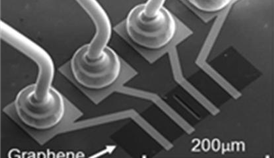Graphene Beats Silicon in Strain Gauges
on

According to researchers at the Swedish Royal Institute of Technology (KTH) in Stockholm, graphene can increase the sensitivity of micro-electromechanical system (MEMS) sensors by up to 100 times due to exteme thinness of graphene films compared to other piezoresistive materials.
Piezoresistive pressure sensors typically integrate silicon piezoresistors into sensor membranes so that strain can be read in terms of resistance. The MEMS version suspends the membrane over a cavity by etching out the underying silicon dioxide. In the KTH version, an extremely thin layer of graphene is suspended over a cavity etched into a silicon dioxide layer on a silicon substrate. The extreme thinness of the graphene membrane – less than a nanometer with a monolayer membrane – increases the sensitivity of the electromechanical effect.
The researchers confirmed that graphene was the key element of the new sensor topology by wiring the substrate as a gate electrode to obtain the characteristic behavior of a graphene field effect transistor. In the strain gauge configuration the measured piezoelectric gauge factor was just under 3. However, the researchers claim that using their topology in a typical strain gauge setup would result in sensors just a few microns in length, compared to hundreds of microns with currently available silicon piezoresistive sensors.


Discussion (0 comments)